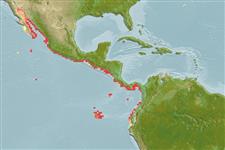Environment: milieu / climate zone / depth range / distribution range
ນິເວດວິທະຍາ
ສັດທະເລ ກ່ຽວກັນຫີນ; ລະດັບຄວາມເລິກ 1 - 37 m (Ref. 27020). Tropical
Eastern Central Pacific: Gulf of California to Gorgona Island, Colombia.
ຂະໜາດ / ນ້ຳໜັກ / Age
Maturity: Lm ? range ? - ? cm
Max length : 9.0 cm TL ຕົວຜູ້/ບໍ່ມີເພດ; (Ref. 59088)
ຄີ (ໜາມ)ແຂງຢູ່ຫຼັງປາ (ທັງໝົດ) : 7 - 8; ຄີຫຼັງຂອງປາ (ຄີອ່ອນ) (ທັງໝົດ) : 19 - 24; ຄີ(ໜາມ) ແຂງຢູ່ຄີກົ້ນປາ
ກຸ່ມປາກະດູກແຂງ
ຄວາມຖີ່ຂອງກຸ່ມຖ່າຍທອດພັນ
ປາທີ່ມີການເຄື່ອນຍ້າຍຈາກທະເລໄປຫານ້ຳຈືດ ແລະນ້ຳຈືດຫາທະເລ
ປາທີ່ມີການເຄື່ອນຍ້າຍຈາກທະເລແລະໄປໄຂ່ຢູ່ນ້ຳຈືດ
ຄີກົ້ນຂອງປາ
ສັດທີ່ມີກະດູກສັນຫັຼງ
ການຖ່າຍທອດທາງກຳມະພັນຈາກພໍ່ແມ່ຫາລູກ: 3; ຄີກົ້ນຂອງປາ: 17 - 20; ສັດທີ່ມີກະດູກສັນຫຼັງ: 26. Live fish with light yellowish brown body, the center of each scale with dark brown spot thus forming a longitudinal pattern of dark brown lines. Prominent black spot on opercle. A broad-based, long, slender, dermal flap dorsally on eye. Two large pores in mid-interorbital space, one on each side close to the edge of the orbit, with the aperture nearly covered by a flap from the median side. There are several small pores in the median part of interorbital. Tubular anterior nostril when laid back reaching at most half way to posterior nostril (Ref. 27020).
Inhabits rocky crevices. Feeds mainly on small fishes and benthic crustaceans (Ref. 11482).
Life cycle and mating behavior
ການຈະເລີນເຕັມໄວ | ການສືບພັນ | ການວາງໄຂ່ | ໄຂ່ | ຄວາມດົກຂອງໄຂ່ປາ | ຕົວອ່ອນ
Allen, G.R. and D.R. Robertson, 1994. Fishes of the tropical eastern Pacific. University of Hawaii Press, Honolulu. 332 p. (Ref. 11482)
IUCN Red List Status (Ref. 130435: Version 2024-1)
Threat to humans
Harmless
Human uses
ເຄື່ອງມື
Special reports
Download XML
ແຫຼ່ງອີນເຕີເນັດ
Estimates based on models
Preferred temperature (Ref.
123201): 23.4 - 28.5, mean 26.9 °C (based on 28 cells).
Phylogenetic diversity index (Ref.
82804): PD
50 = 0.5001 [Uniqueness, from 0.5 = low to 2.0 = high].
Bayesian length-weight: a=0.01148 (0.00443 - 0.02975), b=3.06 (2.84 - 3.28), in cm total length, based on LWR estimates for this (Sub)family-body shape (Ref.
93245).
ຊັ້ນເຂດຮ້ອນ (Ref.
69278): 3.9 ±0.64 se; based on food items.
Fishing Vulnerability (Ref.
59153): Low vulnerability (10 of 100).
Nutrients (Ref.
124155): Calcium = 122 [62, 248] mg/100g; Iron = 0.858 [0.435, 1.542] mg/100g; Protein = 18.4 [16.5, 20.2] %; Omega3 = 0.191 [0.112, 0.329] g/100g; Selenium = 25.1 [12.6, 49.4] μg/100g; VitaminA = 153 [47, 517] μg/100g; Zinc = 1.76 [1.14, 2.62] mg/100g (wet weight);
